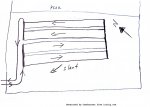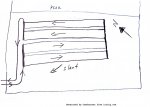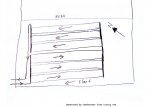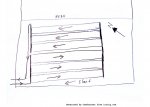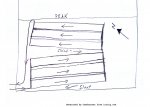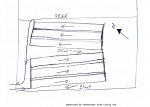I have run sungrabber agp solar panels for a season on my pool. I had 4 panels and now I am adding 2 more to get my total solar panel area closer to my pool surface area. 6 panels (2'X20') will be 240 sq. ft., and my pool is 346 sq. ft. I have stopped at 6 for now since that is what fits nicely in the space I have.
First some background on the sungrabber panels. These panels are the ones with the disk in one header that diverts some of the flow to half of the panel with the return flow back on the other half. I have removed these disks. On an older manual it states the ideal flow rate to be 4-8 gallons/panel. The current online manual does not have a flow rate listed. Instead it talks about throttling the flow rate so that the net increase in pressure when the panels are valved in to not exceed 10 psi. In addition, I am assuming because of the disk, that only a portion of the that flow actually goes through the panels and the rest just sneaks through the hole in the disk on the header (about 0.5 inch in diameter if my memory serves right). So I do not have a good number for an optimal flow rate from the manufacturer. The more I am digging into this, the less I like the sungrabber documentation (or lack of).
Some background on my pool and equipment. I have a 2 speed 1 hp powerflo matrix pump that I was able (marginally, i.e. if my filter was fairly clean) to run the solar on low speed if I primed the panels on high speed first. I would prefer to run on low speed for energy consumption reasons. Last year I was getting about 1.5F bump in water temp through the panels when the sun was strong and the pump was on low. Mark must have just removed his pump graph that had many pump curves on it. My pump ( 1 hp matrix) if I recall at 60 ft head (I am estimating here, I hope to have better numbers after I open), had a flow of about 34 gpm. So for my pump on low speed that would be ~17 gpm. Divided by 3 panels in parallel, that would be ~6 gpm per panel which is why I am thinking doing my panels 3 in series with 3 (I was 2 in series with 2). Again, I do not know have a good number for optimal flow rate for the sungrabbers, but 6 gpm doesn't seem unreasonable to me.
As mentioned above, previously, I ran my flow out two panels then back with the other two. I am assuming that if I run out three, then back three my pressure loss will be a little bit less since my flow rates through the small tubes will go down?
Here is my setup last year when I had 4 panels:
[attachment=2:j8ic7cud]currentsolar.jpg[/attachment:j8ic7cud]
My first thought was more of the same like this:
[attachment=1:j8ic7cud]newsolar1.jpg[/attachment:j8ic7cud]
Another thought was this layout where I avoid possible air entrapment that might exist at upper right portion of the picture above:
[attachment=0:j8ic7cud]newsolar2.jpg[/attachment:j8ic7cud]
Sorry about the ugly drawings, but I did them fast over lunch.
I am interested in leaving the panels on the roof over the winter, so I am motivated to have them at an angle to drain properly.
Any comments or ideas! Thanks!
First some background on the sungrabber panels. These panels are the ones with the disk in one header that diverts some of the flow to half of the panel with the return flow back on the other half. I have removed these disks. On an older manual it states the ideal flow rate to be 4-8 gallons/panel. The current online manual does not have a flow rate listed. Instead it talks about throttling the flow rate so that the net increase in pressure when the panels are valved in to not exceed 10 psi. In addition, I am assuming because of the disk, that only a portion of the that flow actually goes through the panels and the rest just sneaks through the hole in the disk on the header (about 0.5 inch in diameter if my memory serves right). So I do not have a good number for an optimal flow rate from the manufacturer. The more I am digging into this, the less I like the sungrabber documentation (or lack of).
Some background on my pool and equipment. I have a 2 speed 1 hp powerflo matrix pump that I was able (marginally, i.e. if my filter was fairly clean) to run the solar on low speed if I primed the panels on high speed first. I would prefer to run on low speed for energy consumption reasons. Last year I was getting about 1.5F bump in water temp through the panels when the sun was strong and the pump was on low. Mark must have just removed his pump graph that had many pump curves on it. My pump ( 1 hp matrix) if I recall at 60 ft head (I am estimating here, I hope to have better numbers after I open), had a flow of about 34 gpm. So for my pump on low speed that would be ~17 gpm. Divided by 3 panels in parallel, that would be ~6 gpm per panel which is why I am thinking doing my panels 3 in series with 3 (I was 2 in series with 2). Again, I do not know have a good number for optimal flow rate for the sungrabbers, but 6 gpm doesn't seem unreasonable to me.
As mentioned above, previously, I ran my flow out two panels then back with the other two. I am assuming that if I run out three, then back three my pressure loss will be a little bit less since my flow rates through the small tubes will go down?
Here is my setup last year when I had 4 panels:
[attachment=2:j8ic7cud]currentsolar.jpg[/attachment:j8ic7cud]
My first thought was more of the same like this:
[attachment=1:j8ic7cud]newsolar1.jpg[/attachment:j8ic7cud]
Another thought was this layout where I avoid possible air entrapment that might exist at upper right portion of the picture above:
[attachment=0:j8ic7cud]newsolar2.jpg[/attachment:j8ic7cud]
Sorry about the ugly drawings, but I did them fast over lunch.
I am interested in leaving the panels on the roof over the winter, so I am motivated to have them at an angle to drain properly.
Any comments or ideas! Thanks!


